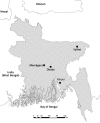Isolation and Full-Genome Characterization of Nipah Viruses from Bats, Bangladesh
- PMID: 30561301
- PMCID: PMC6302578
- DOI: 10.3201/eid2501.180267
Isolation and Full-Genome Characterization of Nipah Viruses from Bats, Bangladesh
Abstract
Despite molecular and serologic evidence of Nipah virus in bats from various locations, attempts to isolate live virus have been largely unsuccessful. We report isolation and full-genome characterization of 10 Nipah virus isolates from Pteropus medius bats sampled in Bangladesh during 2013 and 2014.
Keywords: Bangladesh; Nipah virus; Pteropus medius; bats; enrichment; full-genome characterization; henipavirus; isolation; next-generation sequencing; viruses; zoonoses.
Figures


References
Publication types
MeSH terms
Grants and funding
LinkOut - more resources
Full Text Sources

